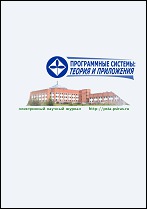|
|
Program Systems: Theory and Applications, 2015, Volume 6, Issue 1, Pages 189–197
(Mi ps164)
|
 |
|
 |
This article is cited in 3 scientific papers (total in 3 papers)
Mathematical Foundations of Programming
A model and algorithm for sequence alignment
S. V. Znamenskij
Program Systems Institute of RAS
Key words and phrases:
similarity of strings, sequence alignment, software development, diff, LCS, edit distance, Levenshtein metric.
Received: 14.12.2014
Accepted: 28.01.2015
Citation:
S. V. Znamenskij, “A model and algorithm for sequence alignment”, Program Systems: Theory and Applications, 6:1 (2015), 189–197
Linking options:
https://www.mathnet.ru/eng/ps164 https://www.mathnet.ru/eng/ps/v6/i1/p189
|

| Statistics & downloads: |
| Abstract page: | 234 | | Full-text PDF : | 67 | | References: | 31 |
|




 Contact us:
Contact us: Terms of Use
Terms of Use
 Registration to the website
Registration to the website Logotypes
Logotypes








 Citation in format
Citation in format 
